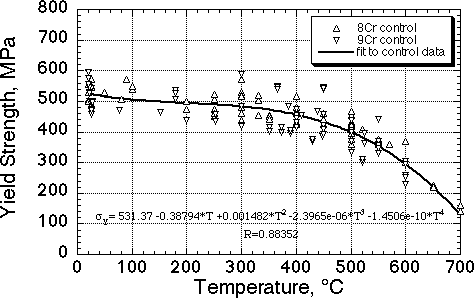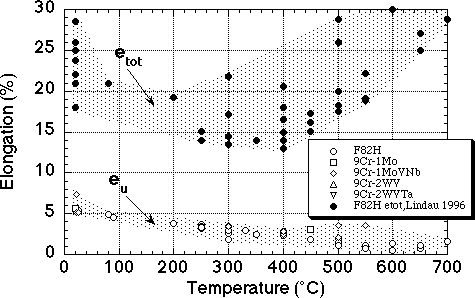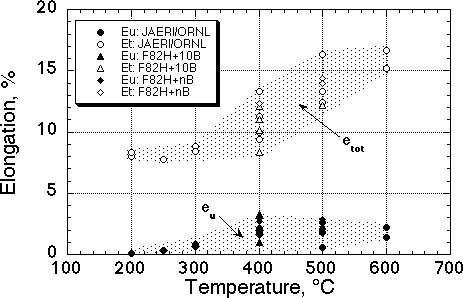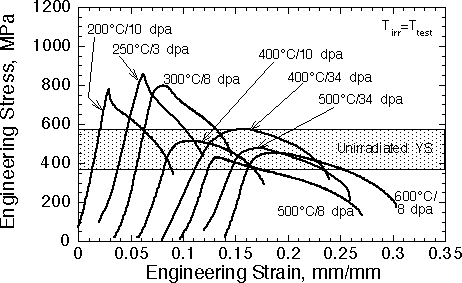2. Yield strength (unirradiated)
3. Yield and ultimate strength (irradiated)
4. Uniform and Total Elongation (unirradiated and irradiated)
5. Reduction in area
6. Stress-strain curves
7. Elastic constants
8. Stress-rupture
9. Thermal expansion, specific heat and thermal conductivity
10. Ductile to brittle transition temperature (unirradiated and irradiated)
11. Recommended reference operating temperature limits
References
1. Ultimate tensile strength (unirradiated)
The ultimate tensile strength for several heats of Fe-(8-9)%Cr reduced activation steels has been measured by numerous researchers. The tensile properties have been found to be comparable to those of conventional Fe-(8-9)%Cr steels. Figure 1 summarizes some of the ultimate tensile strength (UTS) data obtained in tensile tests on F82H (Fe-8%Cr-2%WVTa) and other heats of 8-9Cr (conventional and reduced activation) ferritic/martensitic steels [1-6]. The least squares fitted equation for the ultimate tensile strength over the temperature range of 20-700°C is
where the temperature (T) is in °C. The correlation coefficient for the plotted data using this equation is R=0.8955.

Fig. 1. Ultimate tensile strength of unirradiated 8-9%Cr steels [1-6].
2. Yield strength (unirradiated)
Figure 2 summarizes the yield strength data obtained on several heats of Fe-(8-9)%Cr conventional and reduced activation steels. The least squares fitted equation for the yield strength over the temperature range of 20-700°C is
where the temperature (T) is in °C. The correlation coefficient for the plotted data using this equation is R=0.8835. The corresponding least squares equation fitted only to the yield strength data of F82H reduced activation Fe-8Cr steel is

Fig. 2. Yield strength of unirradiated 8-9%Cr steels [1-4,6].
3. Yield and ultimate strength (irradiated)
Neutron irradiation causes a pronounced increase in the yield and ultimate tensile strength of 8-9%Cr conventional and reduced activation steels at temperatures below ~400°C, but has little effect on the strength at higher temperatures. Figure 3 shows a comparison of the unirradiated and irradiated yield strength for irradiation temperatures between 50 and 600°C. The effects of fusion-relevant helium generation on the yield and ultimate strength have not been adequately studied, although only minor changes have been observed in studies performed to date [7-9].

Fig. 3. Comparison of the yield strength of unirradiated and irradiated 8-9%Cr steels [6].
4. Uniform and Total Elongation (unirradiated and irradiated)
The uniform elongations of unirradiated 8-9%Cr conventional and reduced activation steels exhibit relatively low values (<5%) at all temperatures from 20 to 700°C [6]. As shown in Fig. 4, the unirradiated uniform elongation decreases slowly from ~5% to ~1% over this temperature range. The corresponding total elongations range from ~10 to 30%. As shown in Fig. 5, irradiation causes a decrease in the uniform and total elongations, particularly for irradiation temperatures below 400°C [1-3,6,9,10]. Data for both reduced-activation and conventional Fe-(8-9)%Cr steels are plotted in this figure. The uniform elongation is very low (<3%) at all investigated irradiation temperatures. The total elongation remains above ~7% for all irradiation conditions investigated to date, and it increases with increasing irradiation temperature (Fig. 5). The effects of fusion-relevant helium generation on tensile elongation have not been adequately studied.

Fig. 4. Uniform and total elongation of unirradiated 8-9%Cr steels
[1-3,6].

Fig. 5. Uniform and total elongation of irradiated 8-9%Cr steels [1-3,6]. The test temperature equals the irradiation temperature.
5. Reduction in area
The reduction in area (RA) as measured on unirradiated and irradiated 8-9%Cr steel tensile specimens is shown in Fig. 6 [1,3,6]. The unirradiated reduction in area is high (>80%) at all test temperatures between 20 and 700°C. Irradiation causes a decrease in the RA (particularly at low irradiation and test temperatures), but the reduction in area remains acceptably high in the limited number of tensile specimens examined to date. Helium effects have not been adequately studied.

Fig. 6. Reduction in area of unirradiated and irradiated 8-9%Cr steels [1,3,6].
6. Stress-strain curves
Figure 7 shows representative stress-strain curves obtained on miniature "type SS-3" sheet tensile specimens (0.76 x 1.52 x 7.6 mm gage dimensions) for F82H steel tensile tested at a strain rate of 1.1x10-3 s-1 following neutron irradiation at 200-600°C [6,9,10]. Pronounced flow localization is observed for irradiation temperatures below ~400°C, whereas adequate strain hardening capacity occurs at temperatures >400°C.

Fig. 7. Load vs. normalized crosshead displacement tensile curves for F82H irradiated to 3-34 dpa at 200-600°C [6,9,10].
7. Elastic constants
The elastic constants for F82H (8Cr-2WVTa) have been measured between 20 and 700°C [3,5], and Young's modulus has been measured from -150 to 350°C for several other reduced-activation steels including Fe-9Cr alloys [11]. The temperature-dependent elastic constants for F82H exhibit approximately bilinear behavior, which a slope change occurring near 450-500°C. The change in the temperature dependence of the elastic constants at 450-500°C was attributed to annealing effects on the martensitic structure at the higher temperatures [3,5]. The following equations for Young's modulus (EY) and the shear modulus (G) are obtained from the F82H experimental data [3,5] in the temperature interval between 20 and 450°C:
At temperatures above 450°C, Young's modulus for F82H decreases
approximately linearly from EY=193 to 160 GPa as the temperature is
increased from 450 to 700°C. The shear modulus similarly decreases from G=
75 to 60.5 GPa as the temperature is increased from 450 to 700°C.
Poisson's ratio (n=(EY/2G) - 1) is constant up to 500°C with
a value of 0.29, and then slowly increases to 0.31 at 700°C.
8. Stress-rupture
There have been numerous studies of the creep and stress-rupture behavior of
unirradiated and irradiated 8-9%Cr steels at temperatures up to 650°C (0.5
TM) [1,2,12]. Good creep resistance exists for
temperatures up to
~550°C (0.45 TM), but poor creep resistance occurs at
600°C and above. For example, the 10,000 h creep rupture strength of
F82H is 200 MPa at 550°C, 120 MPa at 600°C and 50 MPa at 650°C
[1]. Improvements in the thermal creep resistance of
reduced-activation
ferritic steels can be achieved with oxide dispersion strengthened alloys
[13].
9. Thermal expansion, specific heat and thermal conductivity
The thermophysical properties for several different heats of F82H (8Cr-2WVTa)
have been measured from room temperature to 700°C
[1,3,5]. The mean
coefficient of thermal expansion (ath) varied from 10.4
ppm/°C at room temperature to 12.4 ppm/°C at 700°C. The
specific heat at constant pressure (CP) varied from 470 J/kg-K at
20°C to 810 J/kg-K at 700°C. The specific heat increase was
approximately linear with temperature between 20 and 500°C, and was
strongly nonlinear above 500°C. The thermal conductivity at 20-800°C
was determined from thermal diffusivity measurements using laser flash
techniques and was found to be nearly independent of temperature, with an
average value of 33 W/m-K between 20 and 700°C for two different heats of
F82H.
10. Ductile to brittle transition temperature (unirradiated and
irradiated)
The measured value of the ductile to brittle transition temperature (DBTT) in
body-centered cubic materials depends on numerous experimental parameters,
including the specimen geometry, strain rate, and the sharpness of the notch
where the crack is initiated (notch acuity) [14]. The
measured DBTT in
miniature unirradiated F82H machined Charpy vee-notch (MCVN) specimens ranges
from about -60°C to -110°C, where the lower DBTT was obtained using
1.5 mm thick Charpy impact specimens [2,9,15]. The DBTT for
unirradiated F82H
measured on precracked compact tension specimens is near -50°C
[16]. Low
temperature irradiation causes a moderate increase in the DBTT (DDBTT~20
to 100°C) of advanced reduced activation 8-9Cr steels for the damage
levels investigated to date
[2,9,10,15,17,18]. Very small changes in the DBTT
(DDBTT <50°C) have been observed in 8-9%Cr steels irradiated at
temperatures above 400°C. The effect of fusion-relevant helium generation
rates on the DBTT in irradiated specimens has not been adequately studied.
11. Recommended reference operating temperature limits
The maximum operating temperature limit for 8-9%Cr reduced activation
ferritic/martensitic steels is ~550°C, due to thermal creep
considerations. Somewhat higher temperatures could be tolerated for components
exposed to low mechanical stresses. Oxide dispersion strengthened ferritic
alloys under development may be capable of operation up to temperatures above
550°C [9]. Additional work on irradiated specimens is
needed before the
minimum operating temperature limit can be established. The reference minimum
operating temperature limit will be controlled by radiation hardening, which
causes loss of ductility and an increase in the ductile to brittle transition
temperature. According to the available irradiation data, the DBTT of 8-9%Cr
steels remains near or below room temperature following neutron irradiation at
temperatures between 200 and 550°C
[2,9,10,15,17,18]. There is some
limited evidence that fusion-relevant helium generation rates may cause a
further increase in the DBTT beyond that attributable to matrix hardening
(defect cluster) effects [8,9,17]. Further work is needed
to determine the
effect of helium on fracture properties. The proposed reference minimum operating temperature for 8-9%Cr steels
is 250°C.
References
[1] N. Yamamouchi, M. Tamura, H. Hayakawa, A. Hishinuma, T. Kondo, J. Nucl.
Mater. 191-194 (1992) 822.
[2] K. Ehrlich, in: Proc. IEA Working Group Meeting on Ferritic/Martensitic
Steels, Culham, UK, October 1996, ORNL/M-5674, ed. R.L. Klueh, Oak Ridge
National Lab, 1996.
[3] K. Shiba, N. Yamanouchi, A. Tohyama, in: Fusion Materials Semiannual
Progress Report for Period ending June 30, 1996, DOE/ER-0313/20 (Oak Ridge
National Lab, 1996) p. 190.
[4] K. Shiba, M. Suzuki, A. Hishinuma, J. Nucl. Mater. 233-237 (1996) 309.
[5] K. Shiba, A. Hishinuma, A. Tohyama, K. Masamura, Japan Atomic Energy
Research Institute Report JAERI-Tech 97-038 (1997).
[6] J.P. Robertson, R.L. Klueh, K. Shiba, A.F. Rowcliffe, presented at 8th Int.
Conf. on Fusion Reactor Materials, Sendai; Fusion Materials Semiann. Prog Rep.
for period ending Dec. 31 1997, DOE/ER-0313/23 (1997) 179.
[7] R.L. Klueh, P.J. Maziasz, J. Nucl. Mater. 187 (1992) 43.
[8] R.L. Klueh, D.J. Alexander, J. Nucl. Mater. 230 (1996) 191.
[9] A. Hishinuma, A. Kohyama, R.L. Klueh, D.S. Gelles, W. Dietz, K. Ehrlich,
8th Int. Conf. on Fusion Reactor Materials, Sendai, J. Nucl. Mater. (1997)
submitted.
[10] A.F. Rowcliffe, J.P. Robertson, E. Wakai, K. Shiba, D.J. Alexander, S.
Jitsukawa, 8th Int. Conf. on Fusion Reactor Materials, Sendai, J. Nucl. Mater.
(1997) submitted.
[11] H.T. Lin, B.A. Chin, in: Fusion Reactor Materials Semiannual Progress
Report for Period ending September 30, 1987, DOE/ER-0313/3, 1987) p. 43.
[12] A. Kohyama, A. Hishinuma, Y. Kohno, K. Shiba, A. Sagara, in: Proc.
ISFNT-4, Tokyo, Japan, 1997) in press.
[13] D.K. Mukhopadhyay, F.H. Froes, D.S. Gelles, presented at 8th Int. Conf. on
Fusion Reactor Materials, Sendai (1997).
[14] G.E. Lucas, G.R. Odette, J.W. Sheckherd, K. Edsinger, B. Wirth, in: Fusion
Materials Semiannual Progress Report for Period ending March 31, 1995,
DOE/ER-0313/18 (Oak Ridge National Lab, 1995) p. 147.
[15] A. Kohyama, in: Proc. IEA Working Group Meeting on Ferritic/Martensitic
Steels, Culham, UK, October 1996, ORNL/M-5674, ed. R.L. Klueh, Oak Ridge
National Lab, 1996.
[16] H.-X. Li, R.H. Jones, J.P. Hirth, D.S. Gelles, J. Nucl. Mater. 233-237
(1996) 258.
[17] R.L. Klueh, D.J. Alexander, J. Nucl. Mater. 218 (1995) 151.
[18] L.E. Schubert, M.L. Hamilton, D.S. Gelles, in: Fusion Materials Semiann.
Progress Report for Period ending June 30, 1996, DOE/ER-0313/20 (Oak Ridge
National Lab, 1996) p. 171.